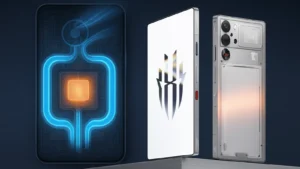Rumors suggest Apple’s first foldable iPhone might use both titanium and aluminum in its frame. (MacRumors) But it’s not just about mixing metals — Apple may use “material zoning,” a method where different parts are made from different materials based on their purpose, a technique used in aircraft, cars, and luxury watches.
Why Folding Phones Push Materials to the Limit
Foldable phones face mechanical challenges that traditional slabs never do. Each open and close motion puts stress right where the device bends — at the hinge. Over time, that constant flexing leads to what engineers call cyclic fatigue — tiny internal cracks that grow with every fold.
Add to that the torsional forces (small twists when you open or grip the phone unevenly) and sidewall stress, and suddenly the choice of frame material becomes critical.
If you could see a stress map of a foldable phone, the hinge area would glow red — the highest load zone — while outer rails would fade to blue, showing much lighter stress.
Apple’s Likely Approach: Divide and Reinforce
Here’s how Apple could strategically “zone” materials within the frame:
- Titanium for the hinge spine and internal reinforcement beams — ultra-strong, corrosion-resistant, and fatigue-tough.
- Aluminum for the outer side rails — lightweight, easy to machine, and ideal for anodized color finishes.
- Steel inserts for hinge pivots or locking cams, where hardness and wear resistance matter most.
- Composite panels or carbon fiber sheets for added stiffness without excess weight.
This multi-material mix could give the iPhone Fold a unique balance: titanium where you need strength, aluminum where you want lightness, and composites where you can afford creativity. It’s the same logic used in aircraft fuselages and high-end watches that combine steel and titanium for the best of both worlds.
Borrowing Lessons from Other Industries
Apple isn’t new to materials innovation. But it could draw inspiration from:
- Aerospace design, where planes like the Boeing 787 use hybrid joints of aluminum, titanium, and composites to manage stress and weight (ScienceDirect).
- EV manufacturing, where cars such as Tesla’s Model Y use “material zoning” in gigacast frames to reinforce crash areas (Mobility Engineering Tech).
- Luxury watchmaking, which has perfected the art of titanium-steel hybrid cases for strength and comfort.
Apple’s mastery of precision machining and micro-joining could make this kind of hybrid structure not only possible — but seamless.
The Hard Part: Making It Work
Mixing metals isn’t easy. Titanium and aluminum expand at different rates when heated, making bonding tricky. There’s also galvanic corrosion, where one metal corrodes faster when in contact with another. Apple would need isolation layers, adhesive bonding, or even friction-stir welding to manage those interfaces.
Then there’s manufacturing precision — those polished, curved edges Apple is known for demand tight machining tolerances, especially where different metals meet. And finally, repairability and recycling get more complex when multiple materials are permanently bonded together.
Still, Apple’s control over its supply chain — and partners like Foxconn — means it’s better positioned than almost anyone to pull this off.
How It Could Feel in Hand
Material zoning doesn’t just improve strength; it changes how a device feels.
By concentrating titanium in the hinge core, Apple could create a sturdier “spine” that makes the fold feel solid and reassuring. Aluminum side rails would keep it light, while carbon fiber panels could balance weight evenly when unfolded.
Apple might even highlight these transitions visually — imagine brushed titanium edges meeting softly anodized aluminum, like a two-tone sculpture in your hand.
The Real Breakthrough Might Be Invisible
Apple has evolved from aluminum unibodies to ceramic shields to titanium frames. Each leap has been about more than aesthetics — it’s been about how materials shape experience.
The iPhone Fold’s biggest innovation might not be its crease-free screen, but what’s hiding underneath: an invisible zoning of materials that quietly redefines what a foldable phone can feel like.
Last Updated on October 18, 2025 by Lucy




